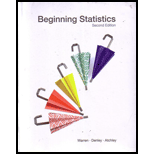
a.
To find:
Effect on margin of error for confidence interval for a population mean if
Answer to Problem 22E
Solution:
When the sample size decreases, there is an increase in the margin of error for a population mean.
Explanation of Solution
Given:
The sample size decreases from
Description:
Given a population with standard deviation
The true population parameters probability lies in this interval range is known as the confidence level
At a certain level of confidence, the interval in which the maximum error can be observed is known as the confidence interval.
The maximum distance from point estimate that the confidence interval covers is margin of error and is given by:
where,
Calculation:
Thus, the ratio of margins of error is:
where
The ratio is calculated as follows:
which gives:
Conclusion:
When the sample size decreases, there is an increase in the margin of error for a population mean.
b.
To find:
Effect on width of confidence interval for a population mean if sample size decreases from 500 to 387 people.
Answer to Problem 22E
Solution:
When the sample size decreases, there is an increase in the width of confidence interval for a population mean.
Explanation of Solution
Given:
The sample size decreases from
Description:
Given a population with standard deviation
The true population parameters probability lies in this interval range is known as the confidence level
At a certain level of confidence, the interval in which the maximum error can be observed is known as the confidence interval.
The maximum distance from point estimate that the confidence interval covers is margin of error and is given by:
where,
Given the sample mean
and width of confidence interval is:
Calculation:
Thus, the ratio of widths of respective confidence intervals is:
where
The ratio is calculated as follows:
which gives:
Conclusion:
When the sample size decreases, there is an increase in the width of confidence interval for a population mean.
Want to see more full solutions like this?
Chapter 8 Solutions
Beginning Statistics, 2nd Edition
 MATLAB: An Introduction with ApplicationsStatisticsISBN:9781119256830Author:Amos GilatPublisher:John Wiley & Sons Inc
MATLAB: An Introduction with ApplicationsStatisticsISBN:9781119256830Author:Amos GilatPublisher:John Wiley & Sons Inc Probability and Statistics for Engineering and th...StatisticsISBN:9781305251809Author:Jay L. DevorePublisher:Cengage Learning
Probability and Statistics for Engineering and th...StatisticsISBN:9781305251809Author:Jay L. DevorePublisher:Cengage Learning Statistics for The Behavioral Sciences (MindTap C...StatisticsISBN:9781305504912Author:Frederick J Gravetter, Larry B. WallnauPublisher:Cengage Learning
Statistics for The Behavioral Sciences (MindTap C...StatisticsISBN:9781305504912Author:Frederick J Gravetter, Larry B. WallnauPublisher:Cengage Learning Elementary Statistics: Picturing the World (7th E...StatisticsISBN:9780134683416Author:Ron Larson, Betsy FarberPublisher:PEARSON
Elementary Statistics: Picturing the World (7th E...StatisticsISBN:9780134683416Author:Ron Larson, Betsy FarberPublisher:PEARSON The Basic Practice of StatisticsStatisticsISBN:9781319042578Author:David S. Moore, William I. Notz, Michael A. FlignerPublisher:W. H. Freeman
The Basic Practice of StatisticsStatisticsISBN:9781319042578Author:David S. Moore, William I. Notz, Michael A. FlignerPublisher:W. H. Freeman Introduction to the Practice of StatisticsStatisticsISBN:9781319013387Author:David S. Moore, George P. McCabe, Bruce A. CraigPublisher:W. H. Freeman
Introduction to the Practice of StatisticsStatisticsISBN:9781319013387Author:David S. Moore, George P. McCabe, Bruce A. CraigPublisher:W. H. Freeman





